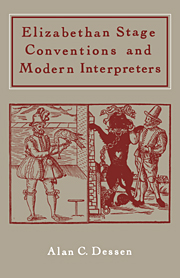Book contents
- Frontmatter
- Contents
- Preface
- Note on texts and old spelling
- 1 The arrow in Nessus: Elizabethan clues and modern detectives
- 2 Interpreting stage directions
- 3 The logic of ‘this’ on the open stage
- 4 Elizabethan darkness and modern lighting
- 5 The logic of ‘place’ and locale
- 6 The logic of stage violence
- 7 Theatrical metaphor: seeing and not-seeing
- 8 Conclusion: Elizabethan playscripts and modern interpreters
- Notes
- List of plays and editions
- Index
2 - Interpreting stage directions
Published online by Cambridge University Press: 22 September 2009
- Frontmatter
- Contents
- Preface
- Note on texts and old spelling
- 1 The arrow in Nessus: Elizabethan clues and modern detectives
- 2 Interpreting stage directions
- 3 The logic of ‘this’ on the open stage
- 4 Elizabethan darkness and modern lighting
- 5 The logic of ‘place’ and locale
- 6 The logic of stage violence
- 7 Theatrical metaphor: seeing and not-seeing
- 8 Conclusion: Elizabethan playscripts and modern interpreters
- Notes
- List of plays and editions
- Index
Summary
Overreach as from dinner
(A New Way to Pay Old Debts, iii. iii. o. s.d.)To recover the theatrical techniques and shared assumptions in the age of Shakespeare is no easy task, for such attempts have been and will continue to be frustrated by the nature of the evidence. First, if one excludes descriptions of masques or other special occasions at court, very few accounts have survived of plays in production. Thus, a recent study devoted to ‘eyewitnesses of Shakespeare’ provides about thirty pages of material written between 1590 and the 1640s, mainly glancing allusions, value judgments, and brief plot summaries (e.g., Simon Forman's accounts of three plays), but included here are few clues about how the plays were staged. Unfortunately for us, contemporary playgoers are rarely informative about what they saw, with the few revealing accounts devoted to lost or little-known plays (e.g., the late moral play, The Cradle of Security). Equally limited is the pictorial evidence. Thus, the often-reproduced Peacham drawing may reflect the staging of the opening scene of Titus Andronicus or may tell us something about the Elizabethan attitude towards ‘period’ costume, but it may just as well reflect the artist's own conception as a reader of the scene, just as the illustrations in printed editions (e.g., Doctor Faustus, The Spanish Tragedy, Swetnam the Woman-Hater) may have little to do with stage presentation (or as much as a drawing in an advertisement today).
- Type
- Chapter
- Information
- Elizabethan Stage Conventions and Modern Interpreters , pp. 19 - 52Publisher: Cambridge University PressPrint publication year: 1984



